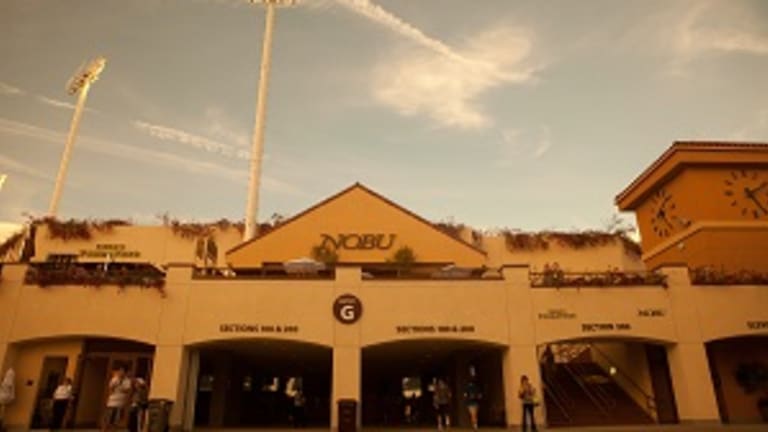INDIAN WELLS, CALIF.—What’s the biggest attraction at the brand-new Stadium 2 here? Judging from its main entrance, it’s all about the...food. When you look at the arena’s low-slung Spanish-style exterior from the middle of the grounds, one word stands out on its front wall. It’s not “tennis.” It’s not “BNP Paribas,” the tournament’s title sponsor. It’s not even “Larry Ellison.” It’s NOBU. Which actually makes sense, in a way. When Ellison, the event's owner, spoke at the stadium’s ground-breaking ceremony here a year ago, the first thing he mentioned was that in 2014 the man standing just behind him at that moment, Roger Federer, was going to be able to order sushi on court “whenever he gets hungry.”
On cue, one year later, Federer made his 2014 debut on Stadium 2 today, in a doubles match with his Davis Cup teammate and new fellow Grand Slam champion, Stan Wawrinka. Federer didn’t get a chance to order anything from Nobu, but his team did get a win over sixth-seeded Rohan Bopanna and Aisam-ul-Haq Quereshi. As expected, the fans of Southern California packed the new house, but this time they seemed as happy to get a glimpse of Federer’s partner as they did the man himself. In the first game, the Swiss team reached deuce on Bopanna’s serve; because no-ad scoring is used in doubles here, that meant Federer and Wawrinka had to choose which of them would return serve on the next point. The spectators near me made their preference clear: “Stan!” three of them yelled in unison. The advice was sound: Wawrinka took the return, and they won the point to break.
Federer spent the first few minutes gazing up and checking out his new surroundings, but his appearance inside the compact, 8,000-seat arena wasn’t an accident.
“I requested to play on Stadium 2, to be honest,” Federer said afterward, “just to see how it was going to be. I’m happy we did, because, I don’t know if it was sold out, but it felt like very, very full. You’re not going to achieve that on center court for doubles. But that was a perfect set-up, and we can thank the tournament and Larry Ellison for building such a court so quickly.”
Federer’s last point isn’t a minor one. This year, the Australian Open was played with its third-largest stadium, Margaret Court Arena, still in the middle of a massive revamping effort. Hammers and drills accompanied early practice sessions; at times it felt like you were watching from the middle of a construction site. When the U.S. Open debuted its new Court 17 three years ago, permanent bleachers had yet to be built. But Ellison’s project, originally scheduled to take 22 months, already feels complete, though there are sure to be additions. The process was helped by the fact that the underground infrastructure was installed before the 2013 event. That’s the benefit of owning the open land surrounding your tournament site.
So far, the reviews have been positive. “It was great,” Federer said of Stadium 2 today. “It’s nice to see the game grow and seeing people coming out and enjoying it.”
